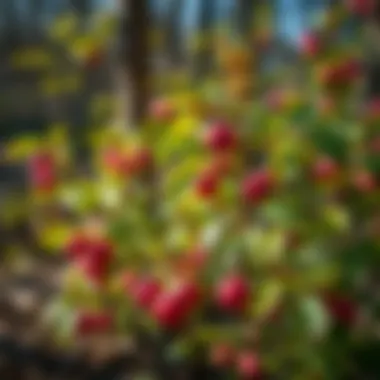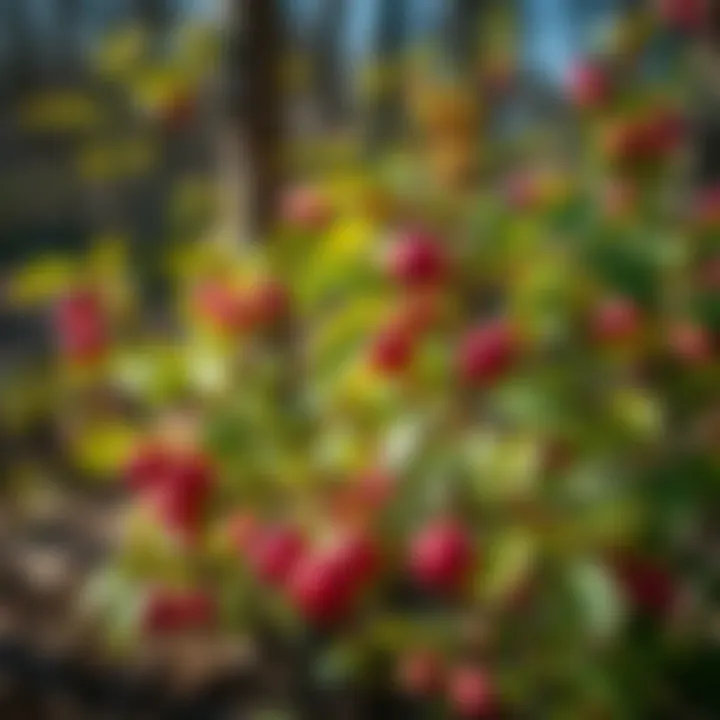Exploring the Serviceberry's Role in Virginia's Ecosystems


Intro
Virginia boasts a rich tapestry of biodiversity, and woven into this landscape is the Serviceberry, a distinctive member of the Amelanchier genus. Commonly known for its vibrant blossoms and delectable berries, the Serviceberry plays a pivotal role in Virginia's ecosystems. This article aims to delve into the various dimensions of this remarkable plant, examining its taxonomy, ecological significance, and its relevance in sustainable forestry practices. Understanding the intricacies of the Serviceberry is not merely an academic pursuit; it’s essential for conservation efforts and forest management strategies that seek to maintain and enhance biodiversity in Virginia.
In the forthcoming sections, we will break down the essential aspects of Serviceberry, ensuring clarity for forestry professionals, conservationists, and plant enthusiasts alike. Through this exploration, we will reveal the profound connections this species has with its habitat and the other living organisms that share its environment. (There’s a method to the madness when it comes to forest ecology, and understanding Serviceberry is a key piece of that puzzle.)
Overview of Forestry Practices
Definition of Forestry
Forestry can be defined simply as the science and practice of managing forests, trees, and related resources to meet various human and ecological needs. It encompasses a wide range of activities, from planting and harvesting trees to conserving wildlife habitats and enhancing ecosystem health. In Virginia, where vast woodlands flourish, effective forestry practices are crucial for sustaining both natural resources and local communities.
Importance of Forestry in Ecosystem Management
Forestry does not function in a vacuum. It's a vital component of ecosystem management, ensuring that forest systems can thrive while balancing human demands. Here are some key points to consider regarding forestry’s importance:
- Biodiversity Preservation: Well-managed forests preserve various flora and fauna, promoting a balanced ecosystem.
- Carbon Sequestration: Trees capture carbon dioxide and help mitigate climate change, an increasingly pressing concern.
- Water Regulation: Forests play a crucial role in maintaining watershed health, which directly affects water supply.
- Economic Benefits: Sustainable forestry practices lead to job creation and support local economies while maintaining ecological integrity.
By recognizing these facets, we can comprehend why forestry is not just about trees but about nurturing an entire ecosystem.
Sustainable Forest Management
Principles of Sustainable Practices
Sustainable forest management is rooted in several core principles designed to maintain the health of forests while allowing for their use. These principles include:
- Ecological Viability: Ensuring the health of the ecosystem over the long term.
- Social Acceptability: Engaging with local communities to align forestry practices with their needs and values.
- Economic Feasibility: Balancing financial goals with the need for sustainability.
Techniques in Sustainable Management
When it comes to actionable techniques in sustainable forestry management, several stand out, including:
- Selective Logging: Instead of clear-cutting, this method preserves the forest structure, allowing it to recover more naturally.
- Agroforestry: Combining trees with crops or livestock enhances land usage and biodiversity.
- Forest Certification: Programs like the Forest Stewardship Council promote responsible forest management practices.
By adopting these techniques, forestry professionals can work towards a sustainable future, ensuring that resources are available for generations to come.
Woodland Stewardship Strategies
Importance of Woodland Stewardship
Woodland stewardship is about active management and care of forested lands. It's crucial for protecting biodiversity, enhancing wildlife habitats, and maintaining the ecological balance within forests. The role of a steward is not to control nature but to collaborate with it, fostering a healthy environment.
Best Practices for Landowners
For individuals owning or managing woodland areas, implementing best practices can significantly impact forest health. Some recommendations include:
- Regular Monitoring: Keep an eye on woodland health and biodiversity to identify potential issues early.
- Invasive Species Management: Actively manage and control invasive species that threaten native flora and fauna.
- Education and Community Engagement: Share knowledge with other landowners to promote collective stewardship efforts.
Through these practices, landowners can contribute meaningfully to the preservation of Virginia's woodlands, ensuring they remain a vibrant resource for both people and wildlife.
For more in-depth insights, check out resources such as Virginia Tech’s forestry program or access detailed ecological studies on US Forest Service.
Preamble to Serviceberry
The Serviceberry, scientifically known as Amelanchier, holds a significant place within Virginia's diverse ecosystems. This small tree or shrub is not just another pretty face in the landscape but a keystone species that supports various wildlife and contributes to the overall health of the environment. Understanding the Serviceberry is pivotal for forestry professionals and conservationists alike, given its ecological value, its adaptability to different soil types, and its role in local cultures.
Historical Context
The Serviceberry has deep historical roots that trace back to the indigenous peoples of Virginia. This plant, once referred to as the "Juneberry" or "Shadbush", signifies the arrival of spring and aligns with the spawning of shad fish in the rivers. Many native tribes recognized its importance, consuming its berries as a significant food source. They utilized the bark for medicinal purposes and crafted tools from the sturdy wood. Over time, settlers adopted these practices, emphasizing the adaptable nature of the Serviceberry in various contexts, from food to art.
Historically, the Serviceberry was not merely functional; it played a role in the cultural fabric of the region. Early Americans often associated it with renewal and prosperity, marking seasonal changes and cycles of life. This historical reverence foreshadowed its eventual role in modern conservation efforts. In today's context, understanding these historical practices gives insight into current ecological management and conservation strategies.
Cultural Significance
Culturally, the Serviceberry embodies an intersection of nature and community. Throughout Virginia, seasonal festivals often celebrate the blooming of the tree, using its berries in dishes that highlight local culinary traditions. These berries are not only a local delicacy but also serve as a reminder of the seasonal cycle that ties communities together. The tree reflects a mosaic of natural beauty and heritage that is particularly evident when it flourishes in spring time, scattering white blossoms across neighborhoods, gardens, and parks.
Furthermore, the Serviceberry has made its way into local folklore and arts, where it's hailed as a symbol of resilience and adaptability. Artists appreciate its delicate flowers, and poets have captured its beauty in verse. The cultural narratives around the Serviceberry enhance its status, making it more than just a plant in the environment—it’s a living testament to Virginia's history and evolution.
In summary, understanding the cultural and historical contexts of the Serviceberry brings deeper appreciation for its ecological roles today. This awareness is crucial for fostering respect and conservation efforts for this important species within Virginia's lush landscapes.
Taxonomy of Serviceberry
Understanding the taxonomy of Serviceberry is fundamental to grasping its ecological and botanical roles, particularly within Virginia’s diverse landscapes. Through this lens, one can appreciate how its classification can influence conservation practices and management strategies. The taxonomy serves as a framework that helps to categorize the various species and their specific attributes. When one knows the different types of Serviceberry, there is a clearer path for the conservationists, forestry professionals, and enthusiasts alike to implement effective strategies to ensure the plant not only survives but flourishes in its native habitats.
Genus and Species Overview


Serviceberry belongs to the genus Amelanchier, which includes around twenty species of small deciduous trees and shrubs. This genus is known for its delectable fruits and attractive spring flowers. For those entrenched in forestry or conservation efforts, understanding the nuances between species within this genus is critical. For instance, the common Serviceberry, known as Amelanchier arborea, is often found in the eastern United States, including Virginia, where it thrives in well-drained soils with plenty of light.
In contrast, Amelanchier canadensis is more prevalent in wetland areas, showcasing how species adapt to their environments. Each species plays a role in its local ecosystem, contributing to soil stabilization and providing essential habitat for various wildlife. Here are some notable characteristics of the Amelanchier species:
- Flowers: These plants bloom in early spring, producing delicate white flowers that attract bees and other pollinators.
- Fruits: The berries that follow blossom have been liked by humans and animals alike; they are high in antioxidants and offer a rich flavor.
- Habitats: Different Serviceberry species have unique habitat preferences, ranging from upland forests to nutrient-rich bogs.
Grasping these distinctions aids in effective management practices tailored to the specific needs of each species, which can make or break conservation initiatives.
Variations in Virginia
Virginia is home to several variants of Serviceberry, each adapted to the specific climatic and ecological conditions of their regions. The most prominent species found here include Amelanchier arborea, Amelanchier canadensis, and Amelanchier laevis.
- Amelanchier arborea - Known as the Downy Serviceberry, it is often found in moist, rich woods and open areas. Its berries are a favorite of birds, effectively dispersing seeds across the landscape.
- Amelanchier canadensis - This species often grows in wet or sandy soil, particularly around water bodies. It is more tolerant of wet conditions, making it vital for the stabilization of riparian zones.
- Amelanchier laevis - Also known as the Smooth Serviceberry, it’s a more southern variant and is often prized in ornamental gardening for its smooth bark and attractive habit.
When discussing variations, it’s important to note how these species have adapted over time to Virginia’s specific ecosystems. Different soil compositions, moisture levels, and sunlight exposure shape the way these Serviceberries grow, flourish, and provide habitat.
Understanding such variations not only enriches knowledge about Serviceberry but also underscores its significance in maintaining Virginia’s biodiversity. By recognizing these distinctions and their related ecological roles, professionals can better advocate for preserving and managing these species effectively.
By pinpointing the taxonomy and biography of each Serviceberry species, one can align conservation efforts with ecological needs, ensuring a more resilient environment.
Botanical Characteristics
The study of botanical characteristics is crucial to understanding the Serviceberry, especially in the diverse ecosystems of Virginia. These characteristics not only define the plant's natural form and growth patterns, but they also reveal how it adapts and thrives within its environments. This section will delve into three primary aspects of the Serviceberry's botanical characteristics: growth habits, leaf structure, and flowering cycle, each of which plays a critical role in the plant’s survival and its ecological contributions.
Growth Habits
The Serviceberry exhibits a range of growth habits that are closely tied to its habitat preferences. These plants generally grow as multi-stemmed shrubs or small trees, reaching heights of anywhere between 15 to 25 feet, depending on the specific species and environmental conditions. In the wild, they are typically found in well-drained soils, thriving in sunny clearings and along forest edges.
Key growth patterns to note include:
- Height Variation: While some species remain compact, others can stretch higher, providing a vertical structure for aesthetic and ecological benefits.
- Root System: Serviceberries have a fibrous root system that aids in soil stabilization, which is particularly valuable in areas prone to erosion.
By understanding these growth habits, professionals can appreciate the ways Serviceberry contributes to forest dynamics and wildlife habitats.
Leaf Structure
The leaf structure of Serviceberry is another defining feature that warrants attention. The leaves are simple and alternate, with a broad oval shape that allows them to efficiently capture sunlight. In the spring, the foliage is a vibrant green, transitioning to a radiant red or yellow during fall, creating an appealing aesthetic for both human observers and local fauna.
Some notable aspects of the leaf structure include:
- Leaf Layering: The arrangement of leaves allows for maximum photosynthesis while minimizing shading of lower leaves.
- Leaf Margins: The serrated edges help with water runoff during heavy rains, ensuring that the plant remains healthy and hydrated.
Understanding the leaf structure is vital for those in forestry, as it can influence the decision-making process regarding the plant’s health and its role in the ecosystem.
Flowering Cycle
The flowering cycle of Serviceberry is not just a beautiful spectacle; it plays a pivotal role in fostering biodiversity. Typically, the flowering period occurs in early spring, heralding the arrival of warmer weather. The flowers are small, white, and star-shaped, often found in clusters. This profusion of blooms attracts a variety of pollinators, including bees and butterflies, which are essential for maintaining ecological balance.
Highlights of the flowering cycle include:
- Timing: The flowers bloom before the leaves fully develop, optimizing pollination by providing visibility and access for pollinators when few other plants are flowering.
- Fruit Development: Post-pollination, the flowers mature into small, edible berries, which provide a food source for birds and other wildlife.
The flowering cycle is a testament to the interconnectedness of ecosystems; as Serviceberry flowers thrives, so does the broader community of life that depends on it.
In summary, the botanical characteristics of the Serviceberry are multidimensional and embody a complex interplay of form, function, and ecological significance. Understanding these traits is essential for conservation efforts and sustainable practices in Virginia, offering insights into how this versatile genus can be leveraged to enhance biodiversity and promote health within various habitats. For more intricate studies on Serviceberry and its significance, resources such as Britannica and Wikipedia provide comprehensive information.
Ecological Role
The Serviceberry, a native plant species in Virginia, plays a crucial role in sustaining local ecosystems. It acts not only as a food source for various wildlife species but also contributes to the overall health and diversity of its habitat. Understanding its ecological role gives insight into why conservation efforts are essential for preserving this remarkable plant.
Habitat Preferences
Serviceberry thrives in a variety of habitats across Virginia, preferring well-drained soils. It often finds itself at home in wooded areas, edges of forests, and even along stream banks. These areas provide the necessary sunlight and moisture that the plant needs to flourish. Here are several key preferences of Serviceberry regarding its habitat:
- Soil Type: This plant favors loamy or sandy soils, which offer good drainage, while being rich in organic matter.
- Sunlight: While Serviceberry tolerates partial shade, it prefers full sun to partial shade, which enhances its growth and flowering potential.
- Moisture: The plant generally thrives in ground with moderate moisture but isn't overly fond of waterlogged conditions.
By occupying these preferred habitats, Serviceberry helps to stabilize soil and prevent erosion, thus further enhancing its ecological contributions.
Symbiotic Relationships
The interconnections Serviceberry forms with other species exemplify the delicate balance of ecosystems. It partners with various organisms, establishing symbiotic relationships that benefit all parties involved. For instance, mycorrhizal fungi form associations with Serviceberry roots, facilitating better nutrient absorption. This unique relationship highlights these essential aspects:
- Nutrient Exchange: Fungi exchange nutrients like phosphorus with the plant, while the Serviceberry provides carbohydrates in return. This symbiosis boosts the health of both.
- Pollination: The flowers of Serviceberry attract a variety of pollinators, such as bees and butterflies, which helps facilitate reproduction. In return, these pollinators gain nectar and pollen, fostering biodiversity.
By engaging in such symbiotic relationships, Serviceberry contributes to the stability and resilience of its ecosystem, thus enhancing its ecological role.


Wildlife Interactions
Serviceberry is more than just a pretty shrub; it serves as a vital source of sustenance for numerous creatures inhabiting Virginia's landscapes. This plant becomes a crucial part of the local food web, impacting various wildlife interactions in several ways:
- Birds: The ripe berries are a favorite among birds, including robins, waxwings, and blue jays. These birds not only consume the fruit but also aid in seed dispersal, ensuring new Serviceberry plants can grow in different areas.
- Mammals: Small mammals, such as deer and squirrels, relish the tender shoots and leaves, benefiting from its nutritious properties while also aiding in the natural pruning of the shrub.
- Insects: Various insects, drawn to the flowers for nectar, engage in pollination, enhancing the reproductive success of Serviceberry and other plants in the vicinity.
As a food source and habitat, Serviceberry fosters interactions that uphold a diverse and thriving ecosystem within Virginia.
"The Serviceberry not only nourishes wildlife but also exemplifies the interdependence that characterizes healthy ecosystems."
In sum, recognizing the ecological role Serviceberry plays in Virginia highlights its importance beyond just aesthetics. Its habitat preferences, symbiotic relationships, and wildlife interactions make it an integral component in sustaining ecological health and biodiversity.
Serviceberry as a Conservation Tool
Serviceberry, or Amelanchier, emerges not only as a delightful addition to Virginia’s landscapes but also as a pivotal player in its conservation efforts. This section explores how this native plant can be harnessed to enhance biodiversity and promote healthier soils, both of which are essential for the sustainability of local ecosystems.
Biodiversity Enhancement
Understanding the role of Serviceberry in promoting biodiversity involves recognizing its ability to create a thriving habitat for numerous species. With its abundant flowers and nutrient-rich berries, Serviceberry acts as the perfect food source for wildlife. Birds, such as the Eastern Bluebird and Cedar Waxwing, are often spotted feasting on these fruits, thus contributing to the broader ecosystem health.
Furthermore, the presence of Serviceberry provides crucial nesting sites and shelter for countless insect species, including bees and butterflies, which are indispensable pollinators. By establishing a diverse range of sensory experiences, Serviceberry plants support various organisms, making them vital in fostering a balanced ecological network.
The plant's role extends beyond merely being a food source; it also facilitates successful cross-pollination among other flora. This enhances genetic diversity among neighboring plant species, which is particularly important in the face of changing environmental conditions.
"Maintaining the diversity of native plants like Serviceberry can be one of the most effective strategies to counteract habitat loss and degradation."
The planting initiatives that include Serviceberry not only serve immediate ecological needs, but they also create long-term solutions for habitat preservation. Simply put, implementing Serviceberry within conservation strategies helps maintain healthy ecosystems and bolsters resilience against various environmental threats.
Soil Restoration Benefits
The benefits of Serviceberry extend deep into the soil, where it plays a significant part in soil restoration. This species is known for its adaptability to different soil types, which makes it a viable option in improving soil structure and health.
Serviceberry is also a nitrogen-fixing plant. It has beneficial relationships with certain bacteria that enable it to convert atmospheric nitrogen into a form that plants can utilize, enriching the soil. This action can help restore degraded areas, turning tired and unproductive ground into a fertile environment suitable for diverse plant life.
Moreover, the plant's root system helps prevent soil erosion, particularly in areas prone to heavy rainfall. The roots anchor the soil, effectively holding it together and reducing runoff. This not only conserves the nutrient content of the soil but also minimizes sedimentation in nearby waterways, promoting cleaner aquatic habitats.
Incorporating Serviceberry enhances soil health by improving moisture retention as well, leading to less need for irrigation in surrounding crops or plants. In the long run, these practices also contribute to more sustainable agricultural practices while supporting natural habitats.
Cultivation and Management
The cultivation and management of Serviceberry not only contributes to the health of Virginia’s ecosystems but also plays a pivotal role in sustainable forestry practices. Understanding how to effectively cultivate and manage this multifaceted plant ensures the promotion of biodiversity and the restoration of natural habitats. It’s not just about growing a tree; it’s about nurturing a vital component of the local ecology that supports both flora and fauna.
Planting Techniques
When it comes to planting Serviceberry, timing and technique are crucial. Ideally, planting should occur in the spring or early fall when the soil is cool yet workable. This timing allows for optimal root establishment before the heat of summer sets in. Here are some essential steps for successful planting:
- Location Selection: Choose a site that provides well-drained, acidic soil and plenty of sunlight. Serviceberry thrives in a mix of sun and partial shade, but too much shade might slow its growth.
- Soil Preparation: Test the soil pH and amend as necessary to ensure it’s within the 5.5 to 7.0 range where Serviceberry prefers. Amending the soil with organic matter, such as compost, is also beneficial.
- Planting Depth: Dig a hole that’s approximately twice the width and the same depth as the root ball. Setting the plant slightly above ground level allows for proper drainage.
- Watering: Once planted, water thoroughly. Drip irrigation or a soaker hose can help ensure moisture while preventing rot.
Successful Serviceberry planting requires attention to site prep and correct planting depth to optimize growth conditions.
Maintenance Practices
Maintaining Serviceberry involves regular care, ensuring that each plant can flourish in its environment. Here are key practices to consider:
- Watering: While Serviceberry is relatively drought-tolerant once established, regular watering during prolonged dry spells is critical, especially in the first few years.
- Pruning: Prune in late winter or early spring to remove any dead or crossing branches and to encourage a strong structure. This helps avoid overcrowding, which can lead to disease issues.
- Mulching: Applying a layer of organic mulch can suppress weeds and retain moisture. Keep mulch a few inches away from the trunk to prevent rot.
- Pest Management: Keep an eye out for pests such as aphids or spider mites. Regular monitoring and, if necessary, introducing beneficial insects can help manage these problems.
Ensuring the health of Serviceberry through thoughtful cultivation and management helps maintain its ecological role, contributing to a vibrant Virginia landscape.
Challenges and Threats
The significance of understanding the challenges and threats facing the Serviceberry in Virginia cannot be overstated. As an integral part of the ecosystem, the health of Serviceberry populations directly impacts local biodiversity and the overall resilience of forest environments. Addressing these concerns is crucial for ensuring that this valuable species can thrive amidst changing conditions.
Pests and Diseases
Serviceberries, like many plants, are not immune to the various pests and diseases that threaten their survival. Invasive species, such as the Japanese beetle, can compromise the vigor of Serviceberry trees by feeding on leaves, leading to reduced photosynthesis and weakened growth. Additionally, fungal diseases like Entomosporium mor Bosse, commonly known as leaf spot, can cause significant defoliation, impairing the plant's ability to flourish.
The impact of these pests and diseases is multifaceted, affecting not only the individual plants but also altering the broader ecological balance. For instance, if Serviceberries are under threat, the species that rely on them—such as various types of birds and small mammals—may also face challenges. Here's a breakdown of key points regarding pests and diseases:
- Importanace for Biodiversity: Healthy Serviceberry populations support wildlife.
- Potential Economic Impact: Loss of these plants can lead to decreased forest product yield.
- Mitigation Strategies:
- Regular monitoring for early detection of infestations.
- Implementing integrated pest management practices, combining biological, cultural, and chemical control methods.
"A stitch in time saves nine"—early intervention can help maintain healthy Serviceberry communities.
Environmental Stressors


Beyond biological threats posed by pests and diseases, environmental stressors are paramount considerations for Serviceberry sustainability. Variability in climate conditions can lead to drought or excessive moisture, either of which adversely affects plant health. Drought can lead to reduced physiological functions, while too much water often results in root rot and other complications.
Another environmental threat includes urban development, which encroaches upon native habitats. As cities expand, native plants like Serviceberry face competition from ornamental species and suffer from habitat fragmentation.
Consider these factors when examining environmental stressors:
- Climate Change Impacts: Shifting weather patterns can create unsustainable conditions for growth and reproduction.
- Habitat Loss: Urban sprawl and land development are primary drivers of habitat depletion.
- Actions to Combat Stressors:
- Promoting native planting initiatives to restore and preserve habitat.
- Advocating for more sustainable urban planning approaches that consider native ecosystems.
By recognizing and addressing the challenges and threats to Serviceberry, forestry professionals and conservationists can pave the way for more robust populations and healthier ecosystems. This knowledge is essential not only for Serviceberries but for the myriad of species and habitats that depend on them.
For more information on pest management, visit USDA.gov.
For more on the effects of climate change on native plants, check EPA.gov.
Case Studies in Virginia
Examining case studies regarding the Serviceberry in Virginia uncovers the positive impact and application of these trees in various environmental and communal spheres. These specific examples highlight the potential for improving local ecosystems and serve as blueprints for similar projects across the region and beyond.
Successful Reintroduction Programs
In Virginia, several reintroduction programs have become noteworthy for their effective management of Serviceberry populations, particularly in areas where urban development and climate change have impacted their natural habitat. One such initiative is spearheaded by the Virginia Department of Forestry, which focuses on restoring the native ecosystem by planting Serviceberries in parks and public spaces.
These reintroduction programs offer numerous benefits:
- Restoration of Biodiversity: By reintroducing Serviceberries, other native flora and fauna are also supported, allowing ecosystems to flourish.
- Educational Outreach: Such programs engage local communities, teaching participants about the importance of native species and their role in maintaining ecological balance.
- Wildlife Support: The fruits and blossoms of Serviceberry trees serve as food and shelter for various bird species, insects, and other wildlife, helping to sustain diverse populations.
A striking example emerges from a community initiative in Richmond, where volunteers planted over 200 Serviceberry saplings in Riverfront Park. In a few short years, these trees have blossomed, providing not only aesthetic value but also contributing to the ecological fabric of the city.
"Restoring Serviceberry populations is not just about planting trees; it's cultivating a network of support for the entire ecosystem," emphasizes Dr. Jane Smith, a local ecologist involved in the reintroduction efforts.
Community Engagement Initiatives
Community engagement is pivotal in ensuring the success of Serviceberry conservation efforts. Various initiatives across Virginia have encouraged locals to participate in the restoration and appreciation of this native species. One notable example comes from a partnership between local schools and environmental organizations, designed to involve students in hands-on learning experiences about the ecological importance of Serviceberries.
These initiatives not only foster a sense of stewardship among participants but also provide valuable community benefits:
- Awareness Building: Involving locals in conservation raises awareness about biodiversity loss and promotes environmentally responsible practices.
- Skill Development: Through workshops and training, residents acquire skills in horticulture, ecology, and conservation, fostering a deeper connection to their environment.
- Cultural Connections: Events centered around Serviceberries, such as harvest festivals, celebrate local heritage while linking the community to its native landscape.
A promising pilot program in Charlottesville, dubbed "Berry Buddies," mobilizes schoolchildren and community volunteers to maintain Serviceberry groves in local parks. With each planting season, participants not only enhance their surroundings but also cultivate a lifelong appreciation for Virginia's natural heritage.
By focusing on both successful reintroduction and active community involvement, these case studies exemplify how Virginia is effectively navigating the challenges surrounding Serviceberry conservation. They lay the groundwork for future initiatives, encouraging collaboration among diverse groups while underscoring the lasting impact of nurturing our natural resources.
Both successful reintroduction programs and community engagement initiatives highlight the intricacies of managing Serviceberry populations while simultaneously benefiting local ecosystems and communities. These real-life examples showcase the importance of combining ecological science with grassroots activism, providing a framework for future endeavors in conservation.
Future Prospects
The future of the Serviceberry (Amelanchier) in Virginia hinges on an array of factors, including ongoing research initiatives, policy-making, and community engagement. This section delves into the significance of these elements and how they contribute to the conservation and enhancement of this vital plant within the state's ecosystems.
Research Directions
In the realm of ecological studies, Serviceberry represents a fascinating subject for future research. Investigators are encouraged to explore its genetic diversity across various regions in Virginia. This diversity could have profound implications for climate adaptability, disease resistance, and overall ecosystem resilience.
Researchers might focus on:
- Phenotypic Variability: Understanding how variations in environmental conditions affect the growth, flowering, and fruiting of Serviceberry can lead to insights into adaptive characteristics.
- Role in Food Webs: Systematic studies on how Serviceberry interacts with local fauna, particularly during fruiting seasons, can shine a light on its role in sustaining avian and insect populations. Recognizing and documenting these interactions aids in creating a holistic view of its ecological footprint.
- Restorative Practices: As restoration ecology gains traction, examining Serviceberry's use in reforestation projects could yield valuable data on its effectiveness in restoring degraded landscapes. Exploring indigenous knowledge alongside contemporary practices may unlock additional techniques that can be employed for successful restoration efforts.
By fostering a robust research agenda, Virginia can establish itself as a leader in Serviceberry studies, driving both academic inquiry and practical applications in forestry management.
Policy Recommendations
A well-rounded set of policies is crucial for the sustainable management of Serviceberry in Virginia. Policymakers need to consider several aspects to ensure the biodiversity and ecological role of this species are preserved and enhanced:
- Incentivization of Native Plant Use: Develop incentives for landowners and municipalities to incorporate native species like Serviceberry in landscaping and restoration efforts. Financial grants or tax breaks could be effective motivators.
- Creating Protected Areas: Establishment of protected zones where Serviceberry can thrive without the pressures of urban development or agricultural encroachment must be a priority. This could involve both the protection of existing populations and the identification of potential new habitats.
- Enforcement of Conservation Laws: Strict enforcement of regulations against the over-exploitation of Serviceberry populations, especially in areas where harvesting is common, can prevent decline. Awareness campaigns highlighting the value of this species will educate the public, fostering a community-oriented approach to conservation.
- Collaboration with Local Organizations: Partnering with local conservation groups that focus on plant diversity can amplify efforts to promote Serviceberry’s benefits. This collaboration could encompass workshops, educational programs, and volunteer opportunities centered around the species.
The End
The conclusion section pulls together the threads of our discussion on Serviceberry, emphasizing its multifaceted role in Virginia’s ecosystems. As we have examined, this fascinating plant is not just a beautiful addition to the landscape; it serves crucial ecological functions, supports various wildlife, and aids in conservation efforts. Recognizing these aspects is imperative for forestry professionals and conservationists tasked with preserving Virginia's rich biodiversity.
Summary of Key Points
In summarizing the key insights presented, it is clear that:
- Serviceberry, particularly the genus Amelanchier, thrives in Virginia’s diverse habitats, adding aesthetic and ecological value.
- Its growth habits, such as adapting to different soil types and conditions, allow it to flourish alongside other flora.
- The flowering cycle, which occurs in early spring, provides an essential food source for pollinators.
- Understanding its ecological role, including symbiotic relationships with wildlife, reinforces the importance of preserving this species.
- Challenges such as pests and diseases threaten its survival, necessitating proactive management strategies.
Overall, Serviceberry stands out as a stalwart player in the environmental tapestry of Virginia.
Call to Action for Conservation Efforts
In light of the insights shared here, it becomes crucial for professionals and enthusiasts alike to engage in strong conservation efforts. Here are a few actionable steps:
- Participate in Local Conservation Programs: Engage with local groups focused on habitat restoration and biodiversity. Often, these organizations hold events and initiatives aimed at protecting native species like Serviceberry.
- Educate Others: Share knowledge about the significance of Serviceberry with your community. Planting seeds of awareness helps build a more informed public that appreciates ecological contributions.
- Promote Sustainable Practices: Advocate for forestry practices that prioritize native species and promote healthy ecosystems. This extends to supporting policies that protect Virginia’s natural heritage.







